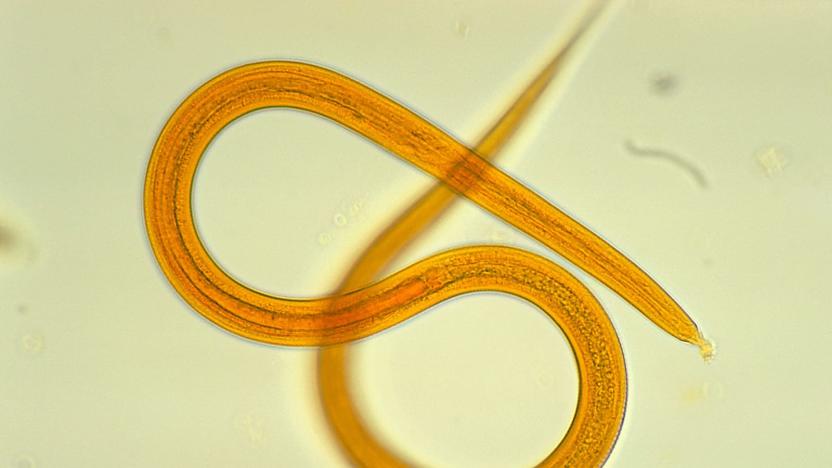nematode
Latest

Scientists say they revived 42,000-year-old frozen worms
A group of scientists in Russia claim to have revived a pair of frozen nematodes, or roundworms, that were between 30,000 and 42,000 years old. One of the specimens was found in a soil sample collected from a ground squirrel burrow located around 100 feet underground, and other burrows nearby have been radiocarbon dated to be around 32,000 years old. A second viable nematode was found in a permafrost sample approximately 41,700 years old collected around 11 feet below the surface.

Watch a worm's brain light up as it plots its next move
Scientists have created the first ever video of neurons firing in a freely moving animal, a technique that could lead to greater understanding about how our own brains work. The Princeton-led team first programmed a nematode worm's neurons to create a fluorescent protein that lit up in response to calcium. Since calcium is generally present when a neuron fires, that means they could literally visualize the 1 millimeter-long worm "thinking" as it wriggles around. The resulting video (below) shows 77 of the nematode's 302 neurons working in the top panel, while the bottom panel simultaneously shows its activities and brain position.

Scientists control a worm's brain cells using sound waves
Forget using clunky headsets and implants to control brain cells... one day, you might only need to use sound waves and some chemicals. Salk Institute scientists have found a way to control the brain cells of a tiny nematode worm through ultrasound. All they need to do to trigger activity is add a membrane ion channel to a neuron cell and blast it with ultrasonic waves -- in this experiment, the researchers changed the worm's direction through sound bursts. The approach is not only relatively unintrusive, but can reach deep into the body. You could trigger neural activity without ever hooking up an electrode, even for much larger animals.

Digitally simulated worm wriggles for the first time (video)
It's relatively easy to simulate life in an abstract sense, but it's tricky to do that cell by cell -- just ask the OpenWorm Project, which has spent months recreating a nematode in software. However, the team recently cleared an important milestone by getting its virtual worm to wiggle for the first time. The project now has an algorithm that triggers the same muscle contractions you'd see in the real organism, getting the 1,000-cell simulation to "swim" in a convincing fashion. There's still a long way to go before OpenWorm has a complete lifeform on its hands, mind you. The group has to introduce code for a nervous system, and performance is a problem -- it takes 72 hours to emulate one-third of a second's worth of activity. If all goes well, though, you'll eventually get to play with the worm through a browser. In the meantime, you can check out the digital critter's motion in a video after the break.

Harvard University controls worm with laser, we wait for choreographed dance moves (video)
Researchers at Harvard University's Center For Brain Science have successful manipulated nematode C. elegans worms by genetically modifying a select few of their 302 neurons. Not to be confused with magnetically controlled invertebrate, these creepy-crawlies are controlled by the CoLBeRT system (a nod to the comedian but no other relation), controlling locomotion and behavior in real time. The scientists can manipulate movement of the worms, induce paralysis, and even cause them to lay eggs all by shining a laser that turns on and off the modified cells at will. The laser hits the worm and causes it to react as if it were being touched. According to the researchers, the reaction is similar to when light is shined in a human eye -- the protein found in the worm and eyes are sensitive to different variations of rays and will respond based on the color shined. Peep past the break for some squiggly mind- er, light-controlled action.


